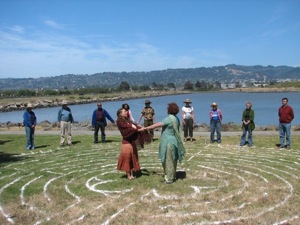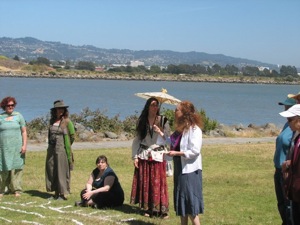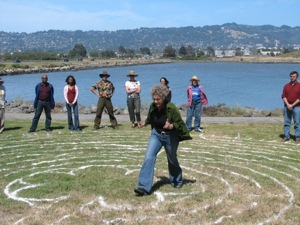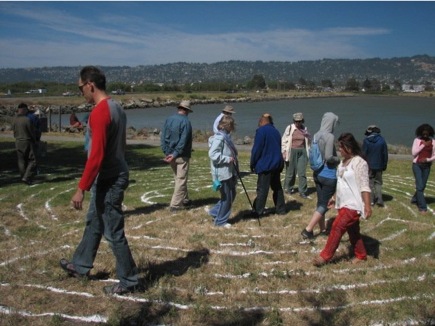


"Sense of place is the sixth sense, an internal compass and map made by memory and spatial perception together."
—Rebecca Solnit
About
fifty people came together Sunday at the Berkeley waterfront to
celebrate the solstice and, I think, to contribute to a sense of place.
Volunteers had marked out a labyrinth in powdered chalk on the grass in
the same pattern as the one placed in Chartres Cathedral in the
thirteenth century. Before we walked it, we stood in a circle around the
labyrinth for an introduction to the walk.
I
had learned about the walk from Nancy Carleton on FaceBook, and I asked
one of those questions with consequences: “Will there be singing?” None
planned, I was told. A man would play an instrumental piece, and Margie
Adam would be there but not as a singer—she would be facilitating the
walk. So would I like to lead a song? Oops! Well, okay, I said I’d lead
Linda Hirschhorn’s “Circle Round for Freedom.” Not easy in the wind with
no mike, and I didn’t really want song sheets, that seemed un-pagan,
somehow. I hoped enough people would know it.

Two
women started the program by invoking the four directions. Then Ellen
Lichtig, one of the organizers talked about community. The East Bay Labyrinth Project
plans to build a permanent, paved, wheelchair-accessible labyrinth on
this site. Meanwhile, the temporary labyrinth will be maintained for a
month and be available to individuals and, by signing up on the website,
to groups.

I
sang, we sang, and Margie Adam talked about the history and meaning of
labyrinth walking and demonstrated that there is no wrong way to do it.

World musician Alan Tower played an original composition on the huaca, a sort of triple ocarina with a haunting, windy sound that perfectly matched the site and the occasion.

and then we walked.

As
we walked in silence, following, meeting and passing other walkers, I
thought of a walking exercise at a week-long storytelling workshop I
went to years ago (twenty?) at Wellspring Renewal Center, on the Navarro
River in Northern California. I was working on the story of Persephone,
and workshop leader Laura Simms
set us each individual tasks, asking me to tell the story as village
gossip to one other participant over a cup of coffee in the dining hall.
We also had group exercises. In one, we were to take a posture like a
character we had a hard time understanding. I chose Hades. Why didn’t he
notice that his wife was catatonic and do something about it? I sat
with him a while and got that he was used to dead people and catatonia
was a step up.
On
a hike that week, Laura walked beside me for a while and we talked
about why I had chosen Persephone. Of course like Demeter I had lost a
daughter, given up for adoption when I was twenty. But Laura said that
also I was like Persephone in having a powerful, well-known mother.
The
walking exercise took place on the basketball court. We were each to
walk in a path representing the journey of one character through our
story, and notice whose paths we crossed, how many meetings repeated,
how we felt. I was traveling a long oval from one basket to the other,
skipping on one half and trudging on the other, representing
Persephone’s year at the end of the story, half in the light and air of
her mother’s world and half in Hades’ chthonic regions. I got that you
can do any job, even being queen of the underworld, if it’s part-time.
As
my long-time readers know, I am part of an on-line group that writes
limericks containing assigned words. When I was searching my computer
for Persephone, this came up:
chthonic • \THAH-nik\ • adjective
: of or relating to the underworld : infernal
Example Sentence:
Laleh compared entering her brother's basement bedroom to a descent into
chthonic regions: it was dark and odd-smelling, and she was a little
frightened of what she might find there.
Did you know?
"Chthonic" might seem a lofty and learned word, but it's actually pretty
down-to-earth in its origin and meaning. It comes from "chth’n," which means
"earth" in Greek, and it is associated with things that dwell in or under
the earth. It is most commonly used in discussions of mythology,
particularly underworld mythology. Hades and Persephone, who reign over the
underworld in Greek mythology, might be called "chthonic deities," for
example. "Chthonic" has broader applications, too. It can be used to
describe something that resembles a mythological underworld (e.g.,"chthonic
darkness"), and it is sometimes used to describe earthly or natural things
(as opposed to those that are elevated or celestial).
~~~~~~~~~~~~~~~~~~~~~~~~~~~~~~~~~~~~~~~~~~~~~~~~~~~~~~~~~
Persephone, queen of realms chthonic,
Had melancholia, chronic
Till her mom asked of Zeus
"Please let her loose
From plutonic king, dour and laconic."
She ate pomegranate, no crime,
Then had to get used to the clime.
"This realm of the dead
Is the pits," so she said,
"But at least the gig's only part-time."
--Nancy Schimmel
I
told the main story of Persephone a few times, and then found another
story about her that I liked better in Jean Shinoda Bolen’s Goddesses in Everywoman.
When Persephone was Queen of the Underworld, she was asked for
assistance by Aphrodite, goddess of love, who had herself fallen in love
with the hunk of the ancient world, Adonis. Adonis loved her back, but
loved hunting too, and she was afraid he’d mar his physical perfection
in a hunting accident. She couldn’t be watching him every minute, she
had goddess things to do, so she boxed him up and sent him to Persephone
for safekeeping. Nothing much happened in Hades, so Persephone wasn’t
that busy. You knew she would open that box. Out popped Adonis, and
Persephone fell for him. Aphrodite was furious. Persephone wouldn’t give
him back. They took the dispute to Zeus, the guy who had set up
Persephone’s job as part-time. He ordained a similar set-up for the
threesome. Four months of the year Adonis was to spend with Persephone,
four months with Aphrodite, and four months with his own handsome self.
 River
stone labyrinth at
River
stone labyrinth at
Thanks to Nancy Carleton for sending the Berkeley photographs.
©2010 by Nancy Schimmel

Monday, June 21, 2010


A SENSE OF PLACE AND TIME: Summer Solstice, 2010






